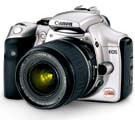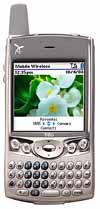
New York (Fortune Magazine) - It's hard to convince people that the Canon EOS Digital Rebel is a serious camera when you're drooling, grinning like a fool, making little "ooh, ahh" noises, and fondling its body like a mother caressing a newborn.
But seriously, Canon's remarkable 6.3-megapixel product is the most exciting digital camera to arrive in what may turn out to be a milestone year for digital photography. This is the year, after all, when the picture quality of top-end digital cameras finally matched and, some might say, exceeded that of traditional 35-millimeter film cameras. The Digital Rebel may not be the best digital camera on the market-there are others with higher resolution, fancier features, and superior construction-but it is definitely the best I've seen under $1,000 (just barely: For $899 you get the body only; for $999 you get the body plus an 18-55mm zoom lens).
 |
|
| Canon EOS Digital Rebel |
This camera's a winner because it's a so-called SLR-that is, single-lens reflex-camera, meaning subjects are viewed and metering is done through the lens for greater control and accuracy. As with other SLRs, but unlike almost all other consumer digital cameras on the market, the Digital Rebel's lenses are interchangeable-by using the standard EF and EF-S lens mounts, Digital Rebel owners can swap lenses with their other Canon film and digital cameras. That's a huge advantage for serious (and well-heeled) photographers.
After shooting gigabytes of pictures with the Digital Rebel on a recent vacation, I'm as happy with the resulting shots as I used to be with prints from my beloved Leica 35mm SLR. And when picture quality is comparable, even for prints as large as 13 inches by 17 inches, the convenience and immediacy of digital tips the scale.
Granted, $999 is still a lot of money for a digital camera, and the tab can climb quickly with optional lenses, extra batteries, and other accessories. Canon doesn't include a Compact Flash Type I or II storage card-the digital equivalent of film-so I spent an extra $135 for a pair of ultra-high-speed 256-megabyte CF cards. (Here's a tip: Storage cards for digital cameras come in different speeds as well as different capacities. The faster the card, the faster the response in taking and reviewing photos.) Yet compared with the $3,000 pricetag for a three-megapixel digital SLR just a few years ago, Canon's achievement in breaking the $1,000 barrier-a digital SLR with lens!-practically rattles the industry with a photonic boom.
The camera's heritage is impressive. The EOS Digital Rebel shares its imaging innards with the popular Canon EOS 10D ($1,500, body only), a digital camera that has been a darling of pro and serious amateur photographers since its introduction six months ago. Like the 10D, the EOS sports a 6.3-megapixel (3,072 x 2,048 pixels) image sensor and Canon's advanced image processor, along with its fast, seven-point autofocus system for precision focusing at the touch of a button. On the outside, though, it's hard to confuse the two. The Rebel has a silver plastic body that, while solid, looks and feels cheaper than the 10D's black magnesium shell. It also lacks some of the 10D's more esoteric software controls. Most amateurs won't miss the tweaks and twiddles.
There are plenty of pleasant surprises for people moving up from a simple point-and-shoot digital camera. Anyone frustrated by long lag time-the time between the press of the shutter release and the taking of the picture, or the dead time between pictures while the camera writes the image to disk-will dig the Digital Rebel's burst mode: up to four shots in less than four seconds, which is great for action shots (though slower than the 10D). There are all sorts of auto-exposure shooting modes to make it easier for novices to take great pictures even in tricky lighting situations. More experienced shooters will find the manual controls over such functions as shutter speed, focus, white balance, and ISO equivalents to be equally satisfying.
My main gripe with the Digital Rebel is its use of a USB 1.1 connection to a PC or Mac instead of the faster USB 2.0 or IEEE 1394 (also called FireWire). But overall, the Digital Rebel is likely to hasten the demise of film cameras.
Handspring Treo 600
Although it has a few glaring omissions-it lacks a corkscrew and an airbag, for example-Handspring's Treo 600 smart phone may be the finest color-screen wireless phone, e-mail, web-browsing, Palm PDA, MP3 music player, messaging, and digital-camera combination yet devised. It's due out later this month-for somewhere over $500-from several carriers, including Cingular, T-Mobile, and Sprint.

Previous Treo models were essentially PDAs with a phone built in. The Treo 600 is the opposite, meaning that for one thing, users no longer look like Martians radioing back to the mother ship when making calls. At the same time, slenderizing the Treo has also shrunk the color display and the built-in keyboard, which is useful for dashing off e-mails and memos or entering contact and calendar information on the fly.
When I first fingered a Treo 600 prototype a few months ago, my reaction was that it was almost too small, with Barbie-sized keyboard buttons. After using the phone for a while, however, I found the dinky keys less annoying, thanks to the clever combination of domed buttons that are more forgiving of fat fingers, and software that is smart enough to figure out which key is the probable choice when two are pressed at once.
The color display screen is impressively bright, which partially offsets the somewhat disappointing but still quite useful 160- by 160-pixel resolution. Best of all, the brightness does not appear to come at the expense of battery life, which was one of the major drawbacks to earlier Treos. The quad-band, GSM-based Cingular model I tested featured nearly five hours of talk time and more than a week of standby time. Sprint declined to provide us with a test model, but Handspring said the dual-band, CDMA-based radio in the Sprint version would have slightly less talk and standby time. (Quad-band means that the GSM version, unlike the Sprint one, can also be used internationally.) On the flip side, the Sprint model is expected to offer faster connections for e-mail and web browsing, although many of Sprint's software services were unfinished at presstime.
Overall performance of everything from data applications to gaming has been speeded by the upgrade to a 144-megahertz Texas Instruments processor and 32 megabytes of system memory. There's a slot for SD cards, which can be stocked with MP3 music files, digital photos, video clips, or boring business-type stuff.
Earlier Treos were two-handed devices-awkward to use while juggling a cup of hot coffee, reading a map, and driving up onto the sidewalk. The Treo 600 has a new four-way rocker button that works brilliantly with Palm OS 5 applications, including calendar, contact lists, and calculator, as well as with the phone and camera features. (Don't expect EOS quality here: The pictures are low resolution-640 x 480 pixels-and there's no flash or zoom, but they're fine for e-mail or small prints.) Another nice touch: The Treo 600 has polyphonic speakers and the ability to download custom ring tones directly from the Internet, bypassing a PC.
On the downside, at around six ounces, the Treo 600 is heavier than your typical cellphone and will definitely put a pucker in your pocket. The screen lacks a cover and easily picks up fingerprints, makeup, and other contaminants. The battery is not removable. Overall, though, the Treo 600 is the smartest of the smart phones.

|

